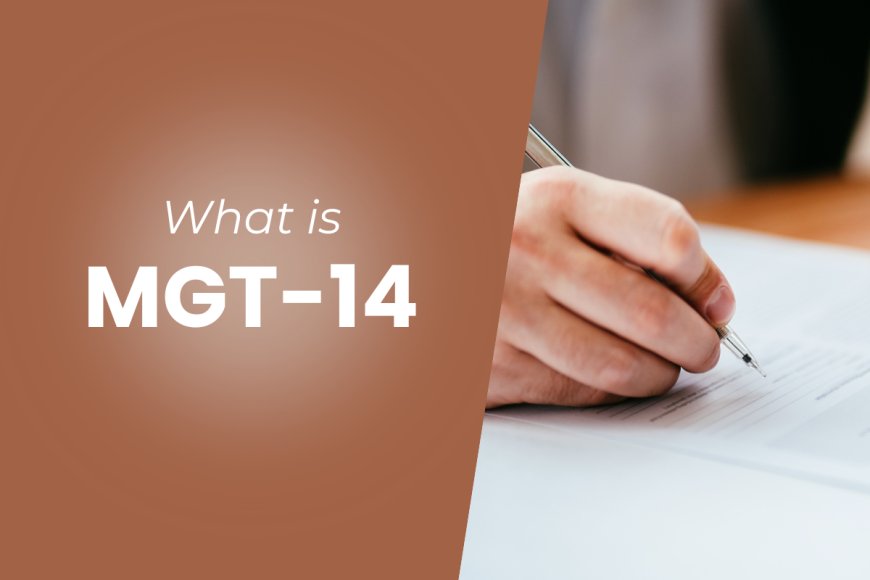Form MGT-14 Explained: Mandatory ROC Filing for Major Company Decisions

Form MGT-14 is a crucial e-form under the Companies Act, 2013, used by companies to file certain resolutions and agreements with the Registrar of Companies (ROC). It essentially serves as a formal way for companies to notify the Ministry of Corporate Affairs (MCA) about significant decisions taken by their Board of Directors or shareholders. Think of it as the official record-keeping mechanism for key company actions beyond the routine.
When to File MGT-14
The timeline for filing Form MGT-14 depends on the nature of the resolution or agreement being filed. However, the general rule is that it needs to be filed with the ROC within 30 days of the passing of the resolution or the execution of the agreement.
Here's a breakdown of common scenarios and the triggering events:
-
Special Resolutions: These are passed at a General Meeting (Extraordinary General Meeting or Annual General Meeting) and require a higher majority (at least 75%). MGT-14 must be filed within 30 days of the date of the General Meeting where the special resolution was passed. Examples include:
-
Alteration of the Memorandum of Association (MOA) or Articles of Association (AOA).
-
Change of registered office outside the local limits of the existing city, town, or village.
-
Issue of further shares.
-
Reduction of share capital.
-
Approval of schemes of arrangement or amalgamation.
-
Winding up of the company by the Tribunal.
-
Certain Board Resolutions: While not all board resolutions require filing in MGT-14, specific ones mandated by Section 117 of the Companies Act, 2013, do. These are typically related to significant matters. MGT-14 must be filed within 30 days of the date of the Board Meeting where the resolution was passed. Examples include resolutions regarding:
-
To borrow money.
-
To invest the funds of the company.
-
To grant loans or guarantees or provide security in respect of loans.
-
To approve financial statements and the Board's report.
-
To diversify the business of the company.
-
Agreements: Certain agreements entered into by the company also need to be filed using MGT-14 within 30 days of the date of the agreement. Examples include:
-
Agreements relating to the appointment, reappointment, or remuneration of a managing director, whole-time director, or manager.
-
Agreements relating to the appointment of a sole-selling agent.
-
Agreements with a body corporate or other entity in which the company's directors are interested.
It's crucial to identify the specific resolution or agreement and adhere to the 30-day filing deadline to avoid penalties.
Requirements to File MGT-14 with ROC/MCA
To file Form MGT-14 with the ROC/MCA, you generally need the following:
-
The e-Form MGT-14: This form is available for download on the MCA portal.
-
Certified True Copy of the Resolution Passed: This should be a duly certified copy of the Board Resolution or Special Resolution, including the date of the meeting and the exact wording of the resolution.
-
Copy of the Agreement (if applicable): If the filing pertains to an agreement, a copy of the executed agreement needs to be attached.
-
Notice of the Meeting (for Special Resolutions): The notice calling the General Meeting where the special resolution was passed is usually required.
-
Explanatory Statement (if applicable): For certain special resolutions, an explanatory statement under the Companies Act, 2013, needs to be attached, providing further details about the resolution.
-
Other relevant documents (as may be applicable based on the specific resolution or agreement): The MCA portal will often specify any additional attachments required.
-
Digital Signatures: The form needs to be digitally signed by a Director and the Company Secretary (if applicable) or a practicing professional (Chartered Accountant, Company Secretary, or Cost Accountant).
What's Your Reaction?
 Like
1
Like
1
 Dislike
0
Dislike
0
 Love
0
Love
0
 Funny
0
Funny
0
 Angry
0
Angry
0
 Sad
0
Sad
0
 Wow
0
Wow
0





























